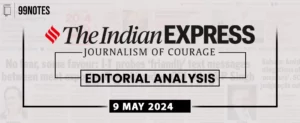(Source – The Hindu, Section – News, Page – 3) Topic: GS2 – Indian Polity The topic highlights electoral reforms, judicial intervention, and the significance of NOTA, relevant for UPSC’s governance and political science syllabus. |
| Context: |
| ● The Supreme Court is reviewing a plea regarding constituencies where NOTA wins, potentially barring candidates with fewer votes from future elections. |
Analysis of news:
- The Supreme Court has asked the Election Commission (EC) to respond to a plea regarding constituencies where NOTA (none of the above) wins majority votes.
- The petition urges the court to direct the EC to establish rules stating that candidates receiving fewer votes than NOTA should be barred from contesting elections for five years.
- NOTA was introduced by the EC and various State Election Commissions in November 2013.
- Some states like Maharashtra, Haryana, Delhi, and Puducherry have treated NOTA as a “fictional electoral candidate” since 2018.
- These states declared that if NOTA wins, there should be a mandatory re-poll, as declaring the second highest candidate as the winner violates the purpose of NOTA.
- The petition argues for uniform application of these rules across the country.
| More About ‘NOTA’ (None of the Above) |
● Introduction: NOTA, or None of the Above, is an electoral option available to voters in India since 2013, allowing them to reject all candidates contesting in an election. ● Purpose: NOTA provides voters with the option to express their dissatisfaction with the listed candidates and the electoral process itself. ● Symbol: NOTA is represented by a symbol on the Electronic Voting Machine (EVM) and appears as a separate option on the ballot paper. ● Legal Status: The Supreme Court of India recognized the right to NOTA as a fundamental right of voters in the landmark judgement of People’s Union for Civil Liberties v. Union of India in 2013. ● Effect: Votes cast for NOTA are counted separately from the total votes polled, and if NOTA receives the highest number of votes, the candidate with the next-highest number of votes is declared the winner. ● Limitations: NOTA does not directly affect the outcome of elections, as the candidate with the highest number of valid votes is still declared the winner, regardless of the NOTA votes. ● Awareness: Despite being available as an option, awareness and utilisation of NOTA among voters remain relatively low. ● Criticism: Critics argue that NOTA lacks teeth as it does not lead to the rejection of candidates or necessitate a re-election, limiting its effectiveness in promoting accountability and electoral reforms. |
| Practice Question: Discuss the significance of the ‘NOTA’ (None of the Above) option in India’s electoral system. Assess its impact on electoral transparency and accountability, and propose potential reforms. (150 Words /10 marks) |












